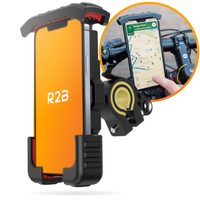No Products in the Cart

Air bubbles under screen protector: causes and solutions
Time to read 3 min
Time to read 3 min
You have just carefully applied your new screen protector to your phone, tablet or smartwatch, but to your frustration you see air bubbles appear. This is a common problem and has several causes:
Dust particles : Even a small dust particle can cause an air bubble.
Uneven Application : If the screen protector is not applied in one smooth motion, air bubbles may become trapped.
Poor adhesion : Some screen protectors do not adhere well, especially if the screen has not been cleaned properly.
Humidity : A humid environment can affect adhesion and trap air under the screen protector.
Fortunately, there are ways to remove and prevent air bubbles.
An easy way to remove air bubbles is to rub the screen with a microfiber cloth or dry tea towel. Start in the middle and gently push the air out to the edges.
A bank card, customer card or a special application tool helps to effectively push air bubbles to the side. Place the card under a cloth to prevent scratches and make wiping movements.
Small air bubbles from dust particles? Use a piece of tape or a dust sticker. Carefully lift the screen protector and remove the dust with the tape before putting the protector down again.
For stubborn bubbles, a little heat can help. Use a hairdryer on the lowest setting and heat the screen for a few seconds. This can make the screen protector more pliable and remove any bubbles.
Make sure you have everything ready before applying the screen protector: the screen protector, a cleaning cloth, a dust sticker/lint-free cloth and possibly a card.
Use a microfiber cloth and possibly a little alcohol to remove grease and dust. Then use a dust sticker to remove the last dust particles.
Hold the right protector by the edges and align it carefully before lowering it onto the screen. Press it from the center outwards.
Use a card or your fingers to immediately push any air bubbles to the edge. The quicker you do this, the easier they will disappear.
This depends on the type of screen protector. Glass screen protectors often lose their adhesion after reuse. A flexible, plastic protector can be reused in some cases, provided it is not damaged and the screen is cleaned properly.
First, remove your phone case.
Use a toothpick or card to loosen a corner of the screen protector.
Slowly pull the protector upwards.
If necessary, you can use a hair dryer on a low setting to loosen the bond.
If a screen protector iPhone 16 no longer adheres properly, check that there is no dust or grease on it. Sometimes it helps to use a little bit of water when applying it, but this does not work with all types. With a glass protector, replacing it is often the only solution.
Some screen protectors, especially hydrogel or matte versions, can be applied with a small amount of water to prevent air bubbles. Bring water in a small bowl to avoid overuse. However, do not use water on tempered glass as this can negatively affect the adhesion.
A well-applied screen protector can last as long as your device. However, scratches and damage can shorten its lifespan. Regular replacement is recommended if the protector becomes damaged.
Are you looking for a new screen protector ? At R2B Store you have screen protectors for iPhone and Samsung phones. An R2B Screen Protector comes with an innovative installation frame and with 2 cleaning kits. Thanks to the installation frame you can prevent air bubbles under your screen protector, for this it is still important to keep your screen clean.
Once your screen is clean, including any remaining dust, you can stick the screen protector on your phone screen in the right place. Follow the instructions carefully for the best results and to ensure that the screen protectors stay on as long as possible.

